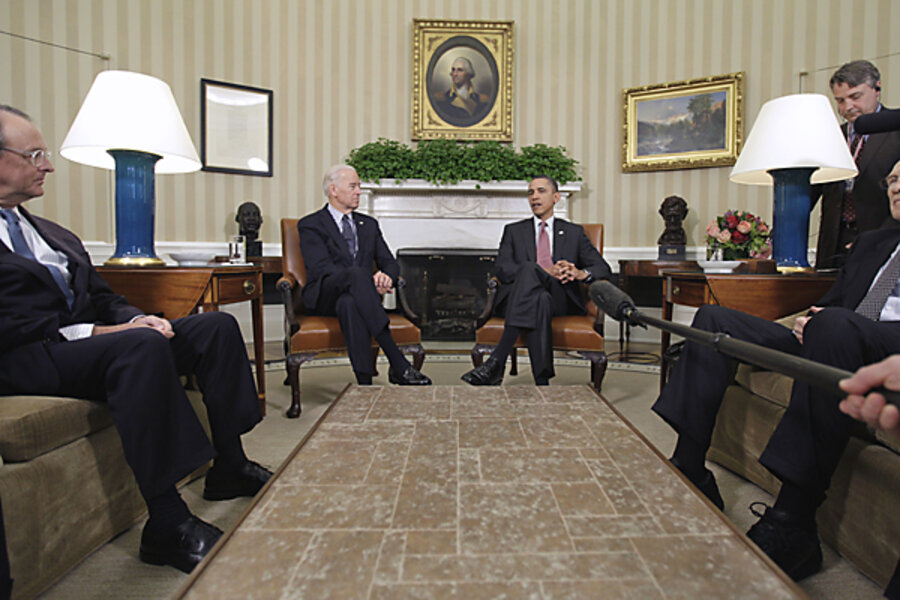Are Obama and Ryan in the same boat?
Loading...
In yesterday’s budget speech, President Obama said that one leg of his fiscal policy stool is “tax reform to cut about $1 trillion in tax expenditures.” But what exactly is he talking about?
Obama mentioned only two tax increases in his speech—both golden goodies. He vowed that he would never extend the 2001 and 2003 tax cuts for high-income households beyond their (latest) expiration date of December, 2012. And he reprised a plan from his past budgets to cap the value of itemized deductions at 28 percent. The rest of the new revenue would come from unspecified changes in deductions, credits, and exclusions.
And then there is the tax reform piece of all this. The White House says some cuts in tax preferences would be used to reduce the deficit and some would finance lower tax rates. How would the new revenues be divided? At the moment, this appears to be a state secret.
As a result, I am struggling to make the president’s numbers add up. Part of the problem is Obama uses —shall we say—a flexible baseline. To make matters even more confusing, yesterday’s speech sometimes targeted 10 year budget savings and sometimes 12 year savings. This obfuscation is no accident and makes it nearly impossible to compare Obama’s plan with the House Republican fiscal plan proposed by Budget Committee Chairman Paul Ryan (R-WI).
Here is what we do know: Obama figures his plan to cap itemized deductions would generate about $320 billion over 10 years. Allowing the Bush-era tax cuts to expire for high-earners would generate another $700 billion. So he’s got his $1 trillion, right?
Not exactly. The President 2012 budget already assumes the 2001-2003 tax cuts for high-earners will expire after next year, so, using his own projections, Obama’s vow to let them die would generate no new revenue at all. Just to make matters more complicated, if you assume all the tax cuts really will expire as scheduled, extending those 2001 and 2003 tax cuts for all but the rich would increase the deficit by $2.4 trillion over 10 years.
Still with me? Now let’s look at Obama’s plan to cap the value of itemized deductions at 28 percent for those high-income taxpayers. Would it really generate another $320 billion? Remember, Obama also says he wants to scale back or even eliminate some tax preferences, many of which are deductions. But the more these deductions are cut back, the less money capping their value will produce.
That brings us to the mysterious $1 trillion in new revenues Obama promises by curbing those tax expenditures. Will they be scaled back only for high-earners? Perhaps, although yesterday Obama dropped his usual mantra about never raising taxes on those making $250,000 or less.
Could Obama raise $700 billion over 10 (or 12) years only on the backs of those high-earners? The Tax Policy Center figures the top five percent of earners receive almost 60 more than 40 percent of the benefits of the $1 trillion in annual tax expenditures, or about $6$400 billion-a-year. Thus, for Obama to grab $70 billion annually, he’d have to cut those tax benefits by nearly 15- 20 percent. The math works, although I’m not so sure about the politics, the economics, our even how such a scheme would work.
When Ryan proposed his own tax plan a few weeks ago, I called it a black box. He would cut the top individual and corporate tax rates to a very specific 25 percent, but he was utterly silent about which tax preferences he’d cut, or by how much. As a result, based on what we know Ryan’s budget ends up cutting taxes for high-income households by $2.9 trillion over 10 years.
In a funny way, Obama and Ryan are in the same boat. They have staked out largely ideological positions while leaving the hot-button details for another time. As a result, neither plan holds up very well when you look too closely. If their tactics lead to an eventual deal, these gaps will be long-forgotten. If not, both initiatives will end up on the growing scrap pile of fiscal plans that never did quite add up.
Add/view comments on this post.
--------------------------
The Christian Science Monitor has assembled a diverse group of the best economy-related bloggers out there. Our guest bloggers are not employed or directed by the Monitor and the views expressed are the bloggers' own, as is responsibility for the content of their blogs. To contact us about a blogger, click here. To add or view a comment on a guest blog, please go to the blogger's own site by clicking on the link above.





